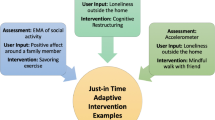Abstract
Depression, a common mental disorder, significantly affects an individual’s ability to live a normal life. Excessive reassurance-seeking is a common interpersonal behavior characteristic of depression and often leads to negative interaction between caregivers and depressed individuals, who seek excessive assurance from the caregivers at inappropriate times, such as when caregivers are busy. Such negative interaction results in elevated feelings of burden for both caregivers and care receivers. However, maintaining a good relationship between depressed individuals and caregivers is crucial to overcoming difficult times during depression. Therefore, we propose a mobile care mediation system that enables depressed individuals and caregivers to share mood and availability information, thus improving communication in caregiving and care-receiving and reducing the caregiving burden.










Similar content being viewed by others
Notes
The BDI-II is a 21-item, self-reported measure of the severity of depression symptoms. Items of various severities of depression symptoms are rated on a 4-point Likert scale, with total scores ranging from 0 to 63.
References
World Health Organization (WHO) (2004) The World Health Report 2004: changing history, annex table 3: burden of disease in DALYs by cause, sex, and mortality stratum in WHO regions, estimates for 2002. WHO, Geneva
World Health Organization (WHO) (2002) Global burden of disease (GBD) 2002 estimates. Estimates of numbers of prevalent cases for selected causes, by sex and WHO region, estimates for 2002. WHO
The Hindustan Times (2001) One out of four mentally ill
Department of Health Executive Yuan (2005) Statistics of causes of death. ROC (Taiwan)
Oquendo MA et al (2001) Ethnic and sex differences in suicide rates relative to major depression in the United States. Am J Psychiatry 158:1652–1658
Yang HJ (2002) A follow-up study of depressive disorders and depressive symptoms in adolescents. National Taiwan University, Taipei, Republic of China
Proudfoot J (2004) Computer-based treatment for anxiety and depression: is it feasible? Is it effective? Neurosci Biobehav Rev 28:353–363
Purves B, Purves D (2007) Computer based psychotherapy for treatment of depression and anxiety. In: 14th annual IEEE international conference and workshops on the engineering of computer-based systems. Tucson, Arizona, USA. IEEE Computer Society, Washington, DC
Warmerdam L, van Straten A, Cuijpers P (2007) Internet-based treatment for adults with depressive symptoms: the protocol of a randomized controlled trial. BMC Psychiatry 7:72
Herman S, Koran L (1998) In vivo measurement of obsessive-compulsive disorder symptoms using palmtop computers. Comput Human Behav 14:449–462
Przeworski A, Newman MG (2004) Palmtop computer-assisted group therapy for social phobia. J Clin Psychol 60:179–188
Joiner T, Coyne JC, Blalock J (1999) On the interpersonal nature of depression: overview and synthesis. In: Joiner T, Coyne JC (eds) The interactional nature of depression. pp 3–19
Joiner T et al (2002) Perceived burdensomeness and suicidality: two studies on the suicide notes of those attempting and those completing suicide. J Soc Clin Psychol 21(5):531–545
Pettit JW, Joiner T (2006) Depression chronicity: perspectives on forms and reasons, in chronic depression: interpersonal sources. In: Pettit JW, Joiner T (eds) Therapeutic solution. American Psychological Association, Washington, DC, pp 3–11
Day M, Rosenberg J, Sugano H (2000) A model for presence and instant messaging. RFC 2778
Debbabi M, Rahman M (2004) The war of presence and instant messaging: right protocols and APIs. In: IEEE consumer communications and networking conference. Las Vegas, Nevada, USA
Intille SS et al. (2003) A context-aware experience sampling tool. In: ACM CHI 2003 extended abstract. ACM Press, New York
Froehlich J et al. (2007) MyExperience: a system for in situ tracing and capturing of user feedback on mobile phones. In: ACM Mobisys. San Juan, Puerto Rico
Mulder I, ter Hofte GH, Kort J (2005) SocioXensor: measuring user behavior and user experience in context with mobile devices. In: Measuring behavior 2005. Wageningen, The Netherlands
Carter S, Mankoff J, Her J (2007) Momento: support for situated Ubicomp experimentation. In ACM CHI 2007. San Jose, California, USA
Mamykina L et al. (2008) MAHI: investigation of social scaffolding for reflective thinking in diabetes management. In ACM CHI 2008. Florence, Italy
Mynatt ED et al. (2001) Digital family portraits: supporting peace of mind for extended family members. In ACM CHI. Seattle, Washington, USA
Consolvo S, Soessler P, Shelton B (2004) The carenet display: lessons learned from and in home evaluation of and ambient display. In: Ubicomp. Nottingham, UK
Consolvo S et al. (2008) Activity sensing in the wild: a field of trial of UbiFit garden. In ACM CHI 2008. Florence, Italy
Chang YC et al. (2008) Playful toothbrush: UbiComp technology for teaching tooth brushing to kindergarten children. In ACM CHI 2008. Florence, Italy
de Sa M, Carrico L, Antunes P (2007) Ubiquitous psychotherapy. IEEE Pervasive Comput 6:20–27
Beck AT, Steer RA, Brown GK (1996) Manual for the beck depression inventory-II. Psychological Corporation, IEEE Pervasive Computing
Watson D, Clark LA, Tellegen A (1988) Development and validation of brief measures of positive and negative affect: the PANAS scale. J Personal Soc Psychol 54:1063–1070
WinWap Technologies. Available from: http://www.winwap.com/
van Wijngaarden B et al. (2000) Caregiving in schizophrenia: development, internal consistency and reliability of the Involvement Evaluation Questionnaire–European Version. EPSILON Study 4. European Psychiatric Services: inputs linked to outcome domains and needs. Br J Psychiatry 177:s21–s27
Joiner TE, Metalsky GI (1995) A prospective test of an integrative interpersonal theory of depression: a naturalistic study of college roommates. J Personal Soc Psychol 69:778–788
Hendrick SS, Dicke A, Hendrick C (1998) The relationship assessment scale. J Soc Pers Relat 15:137–142
Acknowledgments
The study reported in this paper was supported in part by Research Grant from the National Science Council of Taiwan (NSC 96-2413-H-002-012-MY3).
Author information
Authors and Affiliations
Corresponding author
Rights and permissions
About this article
Cite this article
Yu, SH., Wang, LS., Chu, HH. et al. A mobile mediation tool for improving interaction between depressed individuals and caregivers. Pers Ubiquit Comput 15, 695–706 (2011). https://doi.org/10.1007/s00779-010-0347-z
Received:
Accepted:
Published:
Issue Date:
DOI: https://doi.org/10.1007/s00779-010-0347-z




